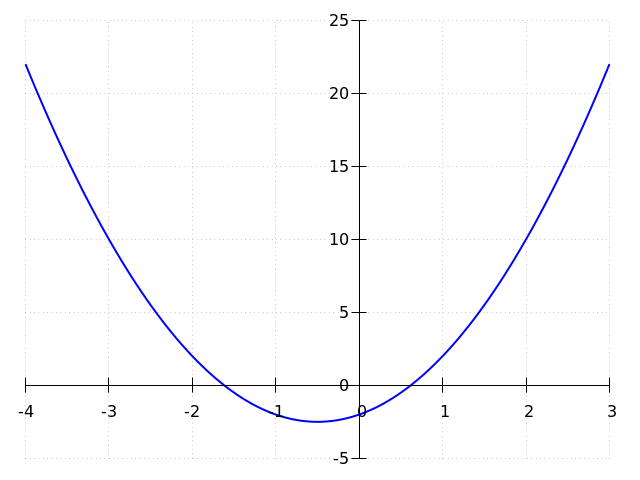Quadratic equations: Solving quadratic equations
 The quadratic formula
The quadratic formula
The equation #x^2+5x+5=0# is an example of a quadratic equation that cannot be solved by factorizing. We could solve this equation by completing the square, but this method can be quite time-consuming, especially as equations become more complex.
For this reason, the quadratic formula, which is derived from the method of completing the square, is commonly used to solve quadratic equations that cannot be solved by factorizing.
The solutions of a quadratic equation in the form \[\blue ax^2+\green bx+\purple c=0\] are:
\[x=\frac{-\green b-\sqrt{\orange D}}{2 \blue a} \lor x=\frac{-\green b+\sqrt{\orange D}}{2 \blue a}\]
#\orange D# is called the discriminant and is calculated as follows:
\[\orange D =\green b^2-4\blue a \purple c\]
The value of #\orange D# determines how many solutions there are:
If #\orange D \lt 0#, there are no solutions.
If #\orange D = 0# there is one solution, namely #x=\frac{-\green b}{2\blue a}#.
If #\orange D \gt 0#, there are two solutions.
We call this the quadratic formula.
The quadratic formula can be used to solve any quadratic equation.
Solving quadratic equations using the quadratic formula
| Procedure | example | |
| Solving a quadratic equation for #x# using the quadratic formula | #3x^2+2x+5=4x+8# | |
| Step 1 |
Reduce the equation to the form #\blue ax^2+\green bx+\purple c=0#. |
#\blue 3x^2\green{-2}x\purple{-3}=0# |
| Step 2 |
Identify #\blue a#, #\green b# and #\purple c#. |
#\blue a =\blue3#, #\green b=\green{-2}# and #\purple c = \purple{-3}# |
| Step 3 |
Calculate the discriminant #\orange D=\green b^2-4\blue a \purple c#. |
#\orange D=(\green{-2})^2-4\cdot \blue3 \cdot (\purple{-3})=\orange{40}\gt0# |
| Step 4 | Determine the number of solutions. If #D \gt 0#, there are #2# solutions. If #D=0#, there is one solution. If #D \lt 0#, then there are no solutions. |
There are two solutions. |
| Step 5 |
Calculate the solutions, simplifying as much as possible. \[x=\frac{-\green b-\sqrt{\orange D}}{2 \blue a} \lor x=\frac{-\green b+\sqrt{\orange D}}{2 \blue a}\] |
# \begin{array}{rcl}x&=&\dfrac{-(\green{-2})-\sqrt{\orange{40}}}{2 \cdot \blue{3}}=\dfrac{1}{3}-\dfrac{\sqrt{10}}{3} \\ &\lor& \\ x&=&\dfrac{-(\green{-2})+\sqrt{\orange{40}}}{2 \cdot \blue3}=\dfrac{1}{3}+\dfrac{\sqrt{10}}{3}\end {array} # |
We solve the equation with the quadratic formula. The equation is already reduced to #0#. Hence, we start at step 2 of the procedure.
| Step 2 | We identify #a#, #b# and #c#. #a=2#, #b=2# and #c=-2# |
| Step 3 | We calculate the discriminant. \[\begin{array}{rcl}D&=&b^2-4ac \\&&\phantom{xxx}\blue{\text{formula for discriminant}}\\ &=& 2^2-4\cdot 2\cdot (-2)\\&&\phantom{xxx}\blue{\text{entered formula}}\\ &=& 20 \\&&\phantom{xxx}\blue{\text{calculated}}\end{array}\] |
| Step 4 | The discriminant #D \gt 0#, hence, the number of solutions is #2#. |
| Step 5 | We determine the solutions of the equation. \[\begin{array}{rcl}s=\dfrac{-b-\sqrt{D}}{2a} &\lor& s=\dfrac{-b+\sqrt{D}}{2a} \\&&\phantom{xxx}\blue{\text{formula for solutions}}\\ s=\dfrac{{-2}-\sqrt{20}}{2 \cdot 2} &\lor& s=\dfrac{{-2}+\sqrt{20}}{2 \cdot 2} \\ &&\phantom{xxx}\blue{\text{entered formula }}\\ s= \displaystyle {{-\sqrt{5}-1}\over{2}} &\lor& s= \displaystyle {{\sqrt{5}-1}\over{2}} \\ &&\phantom{xxx}\blue{\text{simplified}}\\ \end{array}\] |


Or visit omptest.org if jou are taking an OMPT exam.



